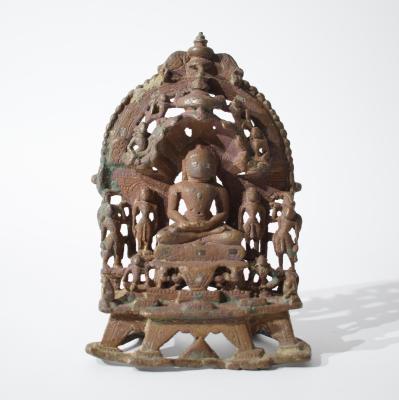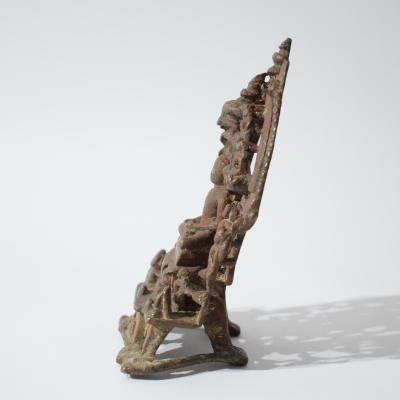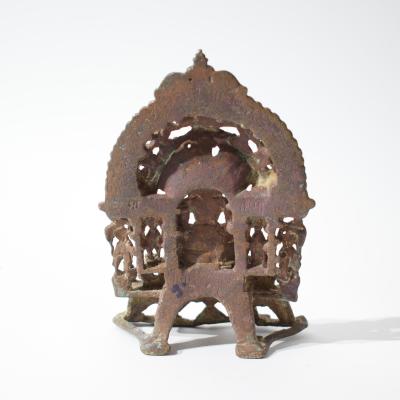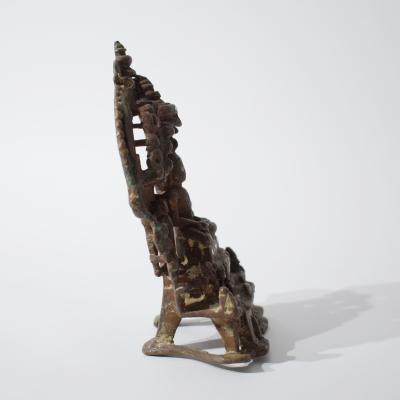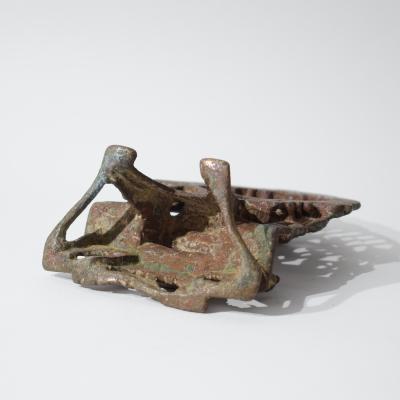Altare votivo jainista con Parshvanatha
L'aggiudicazione sarà gravata di diritti d'asta nella percentuale del 25.00%
Altare votivo jainista con Parshvanatha
India, Gujarat, datato 1316 Vikrama Samvat (1259 AD)
La figura centrale, nuda secondo la tradizione digambara, è seduta in posizione padmasana su un trono ornato e rialzato; le mani sono raccolte in grembo in dhyanamudra. L’iconografia è sobria e dominata dalla presenza di un naga, il grande serpente a più teste che forma il parasole protettivo sulla testa del Tirthankara e attributo iconografico distintivo di Parshvanatha, il ventitreesimo dei Tirthankara jainisti. La figura è affiancata da due assistenti divini, yaksha e yakshi, figure di accompagnamento comuni nelle raffigurazioni tardo-medievali di ambito jainista. L’intera composizione è incorniciata da una prabhamaṇḍala (aureola architettonica) finemente traforata e decorata con una schiera di figure celesti in volo rendono omaggio a Parshvanatha. Il basamento presenta un elegante zoccolo profilato. L’opera è realizzata con la tecnica della fusione a cera persa ed è arricchita da intarsi in rame e argento in ossequio alla tradizione bronzistica dell’India occidentale in epoca medievale. Sul retro dell’altare si trova un’iscrizione in scrittura devanagari medievale parzialmente consunta. La fascia superiore e laterale reca la formula devozionale:
श्री पार्श्वनाथाय नमः “Omaggio al Signore Parshvanatha”
Seguono alcune linee più danneggiate che menzionano con ogni probabilità il nome del donatore (non leggibile) e la datazione in era Vikrama Samvat: संवत् १३१६ (saṃvat 1316) corrispondente all’anno 1259 d.C. del calendario gregoriano.
Provenienza: Collezione Italia centrale.
H 15.5 X 10 cm
Jain devotional altar with Parshvanatha
India, Gujarat, dated 1316 Vikrama Samvat (1259 AD)
The central figure, naked according to the Digambara tradition, is seated in padmasana position on an ornate, raised throne with his hands in dhyanamudra. The iconography is dominated by the presence of a naga, the large multi-headed serpent that forms the protective canopy on the head of the Tirthankara and distinctive iconographic attribute of Parshvanatha, the twenty-third of the Jain Tirthankaras. The figure is flanked by two divine attendants, yaksha and yakshi, accompanying figures common in late medieval depictions of the Jain domain. The entire composition is framed by a finely pierced prabhamaṇḍala (architectural halo) decorated with flying celestial figures paying homage to Parshvanatha. The base has an elegant profiled plinth. The work is made using the lost-wax casting technique and is embellished with copper and silver inlays according to the bronze tradition of Medieval western India. On the back of the altar is an inscription in partially worn medieval Devanagari script. The upper and side band bears the devotional formula:
श्री पार्श्वनाथाय नमः ‘Homage to Lord Parshvanatha’
Some more damaged lines follow, most likely mentioning the name of the donor (not legible) and finally reading a date in the Vikrama Samvat era: संवत् १३६ (saṃvat 1316) corresponding to the year 1259 AD of the Gregorian calendar.
Provenance: Central Italy collection.
H 15.5 X 10 cm
Arte Orientale
Inizio Offerte: 09-06-2025 12:45:02 – Fine Offerte: 30-06-2025 14:00:00

